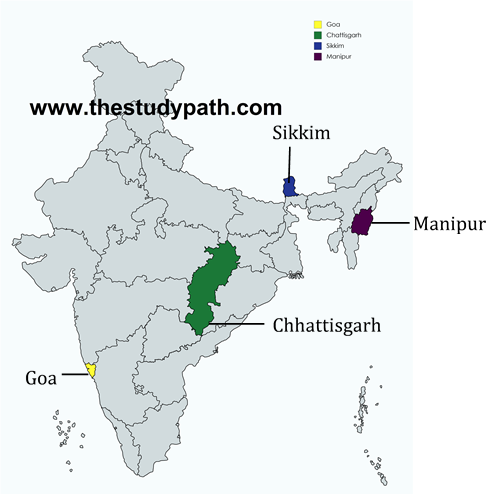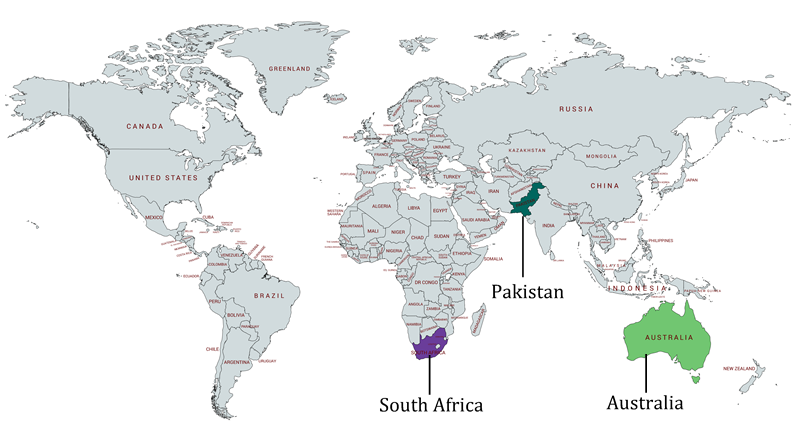NCERT Solutions for Class 10 Civics Chapter 2 Federalism
NCERT Solutions for Class 10 Social Science Civics Chapter 2 Federalism are provided here. With these solutions, you will learn the right way to write answers to the questions perfectly in exams. We have updated the NCERT Solutions for Class 10 Civics Chapter 2 Federalism for the current session so that you can easily score high marks in the exams. You can also download PDF of the solutions and use them whenever you are offline.
Class 10 Social Science Civics Chapter 2 NCERT Solutions
Question 1: Locate the following States on a blank outline political map of India:
Manipur, Sikkim, Chhattisgarh and Goa
Answer:

Question 2: Identify and shade three federal countries (other than India) on a blank outline political map of the world.
Answer:

Question 3: Point out one feature in the practice of federalism in India that is similar to and one feature that is different from that of Belgium.
Answer: Feature in the practice of federalism in India that is similar to that of Belgium – There is power-sharing between the union government and state government.
Feature in the practice of federalism in India that is different from that of Belgium – India has no community government in practice, while Belgium has one.
Question 4: What is the main difference between a federal form of government and a unitary one? Explain with an example.
Answer: In a federal form of government, the central government shares its powers with the various constituent units of the country. For example, in India, power is divided between the government at the Centre and the various State governments.
In a unitary form of government, all the power is exercised by only one government. For example, in Sri Lanka, the national government has all the powers.
Question 5: State any two differences between the local government before and after the constitutional amendment in 1992.
Answer:
| Local governments BEFORE the Constitutional amendment in 1992 | Local governments AFTER the Constitutional amendment in 1992 |
| Elections were not held regularly | It is mandatory to hold regular elections to local government bodies |
| Local governments did not have any powers or resources of their own. | The State governments are required to share some powers and revenue with local government bodies |
Question 6: Fill in the blanks:
Since the United States is a ____________________ type of federation, all the constituent States have equal powers and States are _______________ vis-à-vis the federal government. But India is a _________________ type of federation and some States have more power than others. In India, the ___________________ government has more powers.
Answer: Since the United States is a coming together type of federation, all the constituent States have equal powers and States are strong vis-à-vis the federal government. But India is a holding together type of federation and some States have more power than others. In India, the Central government has more powers.
Question 7: Here are three reactions to the language policy followed in India. Give an argument and an example to support any of these positions.
Sangeeta: The policy of accommodation has strengthened national unity.
Arman: Language-based States have divided us by making everyone conscious of their language.
Harish: This policy has only helped to consolidate the dominance of English over all other languages.
Answer: Sangeeta’s reaction is better than those of the other two. Unlike Sri Lanka (where the language of the majority has been promoted), the Indian polity has given equality of status to all the major languages spoken in the country. This has led to the avoidance of social conflict on linguistic basis. The policy of accommodation has made administration of States easier. It has also ensured a larger participation in the government’s activities by people who speak various languages.
Question 8: The distinguishing feature of a federal government is:
(a) National government gives some powers to the provincial governments.
(b) Power is distributed among the legislature, executive and judiciary.
(c) Elected officials exercise supreme power in the government.
(d) Governmental power is divided between different levels of government.
Answer: (d) Governmental power is divided between different levels of government.
Question 9: A few subjects in various Lists of the Indian Constitution are given here. Group them under the Union, State and Concurrent Lists as provided in the table below.
A. Defence
B. Police
C. Agriculture
D. Education
E. Banking
F. Forests
F. Communications
E. TradeMarriages
| Union List | |
| State List | |
| Concurrent List |
Answer:
| Union List | Defence, Baking, Communication |
| State List | Police, Agriculture, Trade |
| Concurrent List | Education, forests, Marriages |
Question 10: Examine the following pairs that give the level of government in India and the powers of the government at that level to make laws on the subjects mentioned against each. Which of the following pairs is not correctly matched?
| (a) State government | State List |
| (b) Central government | Union List |
| (c) Central and state government | Concurrent List |
| (d) local governments | Residuary Powers |
Answer:
| (d) local governments | Residuary Powers |
Question 11: Match List I with List II and select the correct answer using the codes given below the lists:
| List I | List II |
| 1. Union of India | A. Prime Minister |
| 2. State | B. Sarpanch |
| 3. Municipal Corporation | C. Governor |
| 4. Gram Panchayat | D. Mayor |
| 1 | 2 | 3 | 4 | |
| D | A | B | C | |
| (b) | B | C | D | A |
| (c) | B | D | A | C |
| (d) | C | D | A | B |
Answer:
| 1 | 2 | 3 | 4 | |
| (c) | A | C | D | B |
Question 12: Consider the following statements.
(A) In a federation the powers of the federal and provincial governments are clearlydemarcated.
(B) India is a federation because the powers of the Union and State Governments arespecified in the Constitution and they have exclusive jurisdiction on their respective subjects.
(C) Sri Lanka is a federation because the country is divided into provinces.
(D) India is no longer a federation because some powers of the states have been devolvedto the local government bodies.
Which of the statements given above are correct?
(a) A, B and C
(b) A, C and D
(c) A and B only
(d) B and C only
Answer: (c) A and B only
Class 10 Political Science (Civics) Chapter 2 Federalism: Chapter Overview
In the first chapter, you have learned that vertical division of power among different levels of government is one of the major forms of power sharing in modern democracies. In this chapter, you will learn more about this form of power-sharing. This type of power-sharing is most commonly referred to as federalism. We begin by describing federalism in general terms. This chapter explains the theory and practice of federalism in India. Going through the chapter, you will find a discussion of the federal constitutional provisions. Further, you will see an analysis of the policies and politics that have strengthened federalism in practice. Towards the end of the chapter, it discusses the local government, a new and third tier of Indian federalism.